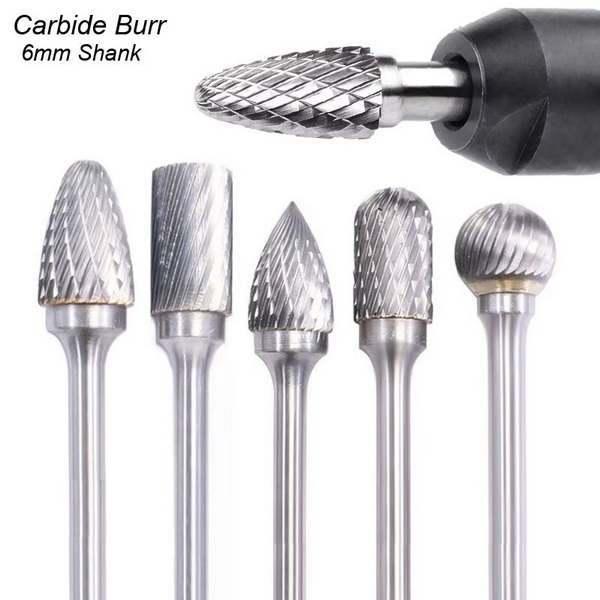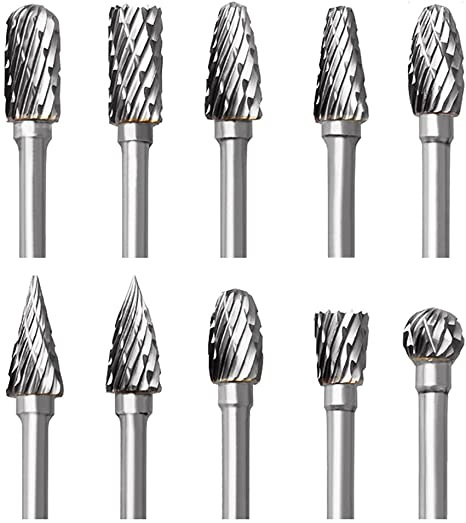Content Menu
● What Are Tungsten Carbide Burrs?
● Composition and Manufacturing Process
● Types of Tungsten Carbide Burrs
● Applications of Tungsten Carbide Burrs
● Benefits of Tungsten Carbide Burrs
● How to Use Tungsten Carbide Burrs Properly
● Maintenance Tips for Tungsten Carbide Burrs
● Advanced Tips for Maximizing Tungsten Carbide Burr Performance
>> Understanding Flute Patterns and Their Impact
>> Using Tungsten Carbide Burrs with Different Materials
>> Safety Considerations
● Innovations and Trends in Tungsten Carbide Burr Technology
● Conclusion
● FAQ
>> 1. What materials can tungsten carbide burrs work on?
>> 2. How do I choose the right shape of tungsten carbide burr?
>> 3. What speed should I use with tungsten carbide burrs?
>> 4. How can I extend the life of my tungsten carbide burrs?
>> 5. Are tungsten carbide burrs better than high-speed steel burrs?
Tungsten carbide burrs are specialized rotary cutting tools widely used across various industries for shaping, grinding, deburring, and carving materials with high precision and efficiency. Known for their exceptional hardness and durability, these burrs are essential for professionals and hobbyists working with metals, wood, plastics, and ceramics. This article explores what tungsten carbide burrs are, their types, applications, benefits, proper usage, and maintenance, providing a comprehensive understanding of these indispensable tools.

What Are Tungsten Carbide Burrs?
Tungsten carbide burrs, also called rotary files or die grinder bits, are small cutting tools made from tungsten carbide-a compound of tungsten and carbon. This material is extremely hard, second only to diamond on the Mohs hardness scale, which allows these burrs to cut through tough materials like stainless steel, titanium, and cast iron with ease.
The burrs are designed to rotate at high speeds, often between 20,000 to 50,000 RPM, enabling rapid and precise material removal. They come attached to shanks of different sizes (commonly 1/8” or 1/4”) to fit into various rotary tools such as die grinders, Dremels, or pneumatic tools.
Composition and Manufacturing Process
Tungsten carbide burrs are manufactured through a meticulous process:
- Raw Material Mixing: Tungsten carbide powder is mixed with a binder, typically cobalt, which influences the hardness and toughness.
- Compaction: The mixture is pressed into the burr shape under high pressure.
- Sintering: The compacted burr is heated in a furnace, causing the binder to melt and fuse the carbide particles into a dense, solid structure.
- Brazing: The carbide head is bonded to a steel shank using a high-strength silver weld, ensuring durability and resistance to cracking.
- Shaping and Grinding: The burr is precisely ground to form sharp cutting edges and the desired geometry.
This process results in burrs with razor-sharp edges and excellent wear resistance, suitable for heavy-duty and fine-detail work alike.
Types of Tungsten Carbide Burrs
Tungsten carbide burrs come in various shapes, each suited for specific tasks:
| Shape | Description & Uses |
| Cylindrical | Straight-sided burrs for contouring, shaping, and enlarging holes. |
| Ball | Spherical burrs ideal for carving, hollowing, and creating concave cuts. |
| Tree (Pointed) | Pointed burrs for tapered cuts, rounding edges, and working in confined spaces. |
| Tree (Ball Nose) | Tree-shaped with a rounded tip, good for smoothing and interior contouring. |
| Conical | Tapered burrs for chamfering, deburring, and shaping concave surfaces. |
| Inverted Cone | Burrs with a flat upper surface and pointed tip downward, perfect for V-cuts and chamfering in tight spots. |
| Flame | Flame-shaped burrs for sculpting and detailed carving with smooth curves. |
| Oval | Oval-shaped burrs combine cylindrical and ball burr benefits, great for rounding edges and smooth cuts. |
| Cone (60° & 90°) | Conical burrs for beveling, chamfering, and making angled cuts. |
Each shape offers unique cutting geometries that cater to different materials and precision levels.
Applications of Tungsten Carbide Burrs
Tungsten carbide burrs are versatile tools used in many industries:
- Metalworking: For deburring sharp edges, weld blending, shaping metal parts, and surface cleaning.
- Automotive and Aerospace: Precision grinding, shaping engine parts, and preparing surfaces.
- Woodworking: Carving intricate designs, shaping, and smoothing wood surfaces.
- Jewelry Making: Detailed engraving and shaping precious metals.
- Dentistry: Precision cutting and shaping in dental laboratories.
- DIY and Hobbyists: Model making, arts, crafts, and general material shaping.
They are especially valuable for working on hard materials such as stainless steel, titanium, cast iron, and hardened alloys, where other tools might fail or wear quickly.

Benefits of Tungsten Carbide Burrs
- Exceptional Hardness and Durability: Last significantly longer than high-speed steel (HSS) burrs, maintaining sharpness even under high temperatures.
- Versatility: Can be used on metals, wood, plastics, ceramics, and composites.
- Precision: Provide smooth finishes and fine detail work with minimal chatter or vibration.
- Efficiency: High-speed rotation and sharp edges enable rapid material removal.
- Cost-Effectiveness: Though initially more expensive, their longevity and performance reduce replacement frequency and downtime.
How to Use Tungsten Carbide Burrs Properly
- Select the Right Burr Shape and Size: Match the burr to your material and task for optimal results.
- Use Appropriate Speed: Hard materials require higher speeds (up to 50,000 RPM), while softer materials need slower speeds to avoid burning or clogging.
- Apply Consistent, Moderate Pressure: Let the burr do the cutting; excessive force can damage both the tool and the workpiece.
- Wear Protective Gear: Safety goggles, gloves, and ear protection are essential due to high-speed operation and flying debris.
- Use Coolants When Needed: To prevent overheating and extend burr life, especially in metalworking.
Maintenance Tips for Tungsten Carbide Burrs
- Regular Inspection: Check for dull edges, chips, or material buildup before use.
- Cleaning: Remove debris with a soft brush and appropriate solvents after each use.
- Proper Storage: Store in a dry place, preferably in a case to avoid damage.
- Avoid Overheating: Excess heat weakens the carbide and shortens tool life.
- Replace When Worn: Signs of wear include increased cutting pressure needed, uneven cuts, or visible damage.
Advanced Tips for Maximizing Tungsten Carbide Burr Performance
Understanding Flute Patterns and Their Impact
Tungsten carbide burrs feature different flute patterns-single cut, double cut, and diamond cut-that influence cutting behavior:
- Single Cut: Burrs with a single set of flutes produce coarse cuts and are excellent for rapid material removal on hard metals.
- Double Cut: Featuring two sets of flutes intersecting, these burrs provide smoother finishes and reduce vibration, ideal for finishing work.
- Diamond Cut: These burrs have a crisscross pattern that offers aggressive cutting with fine control, perfect for hard materials and detailed work.
Choosing the right flute pattern can greatly affect efficiency and surface finish quality.
Using Tungsten Carbide Burrs with Different Materials
While tungsten carbide burrs are versatile, understanding how they interact with various materials can optimize results:
- Metals: Use higher speeds and steady pressure. For stainless steel and titanium, double cut burrs reduce chatter and heat.
- Wood: Lower speeds prevent burning. Single cut burrs are often preferred for fast shaping.
- Plastics: Moderate speeds and light pressure avoid melting or clogging. Diamond cut burrs help maintain clean cuts.
- Ceramics and Composites: Use high speeds with coolant to prevent cracking and overheating.
Safety Considerations
Operating tungsten carbide burrs safely is crucial:
- Always secure your workpiece firmly to avoid slips.
- Maintain a clean workspace to prevent accidents.
- Use dust extraction systems or masks when working with materials that produce fine dust.
- Never force the burr; excessive pressure can cause tool breakage or injury.
Innovations and Trends in Tungsten Carbide Burr Technology
The field of tungsten carbide burrs continues to evolve with advances such as:
- Coatings: Some burrs now come with titanium nitride or other coatings that enhance wear resistance and reduce heat buildup.
- Customized Burrs: Manufacturers offer burrs tailored to specific industries, such as ultra-fine burrs for jewelry or heavy-duty burrs for aerospace.
- Ergonomic Tool Integration: Burrs designed for compatibility with ergonomic rotary tools reduce operator fatigue during prolonged use.
- Eco-Friendly Manufacturing: New processes aim to reduce waste and energy consumption during burr production.
These innovations contribute to better performance, longer tool life, and improved user experience.
Conclusion
Tungsten carbide burrs are indispensable tools for precision cutting, shaping, and deburring in a wide range of industries. Their superior hardness, durability, and versatility make them ideal for working on tough materials with accuracy and efficiency. Understanding the different types, applications, and proper care of these burrs can significantly enhance your craftsmanship and productivity. By selecting the right burr shape, flute pattern, and operating parameters, and by maintaining the tools properly, users can maximize performance and lifespan. Investing in high-quality tungsten carbide burrs and adopting best practices ensures long-lasting performance and excellent results in all your projects.

FAQ
1. What materials can tungsten carbide burrs work on?
Tungsten carbide burrs can efficiently cut, shape, and grind metals (including stainless steel and titanium), wood, plastics, ceramics, and composites, making them highly versatile tools.
2. How do I choose the right shape of tungsten carbide burr?
Choose based on your task: cylindrical for contouring, ball for carving and hollowing, tree shapes for tapered cuts and tight spaces, flame for sculpting, and conical for chamfering and angled cuts.
3. What speed should I use with tungsten carbide burrs?
Hard materials require higher speeds (up to 50,000 RPM), while softer materials like wood or plastics should be worked at lower speeds to avoid burning or clogging.
4. How can I extend the life of my tungsten carbide burrs?
Use proper speeds, apply moderate pressure, clean burrs after use, avoid overheating, and store them properly to prevent damage.
5. Are tungsten carbide burrs better than high-speed steel burrs?
Yes, tungsten carbide burrs are harder, more durable, and maintain sharpness longer, especially under high temperatures, making them superior for heavy-duty and precision tasks.
















